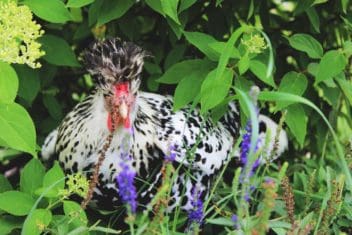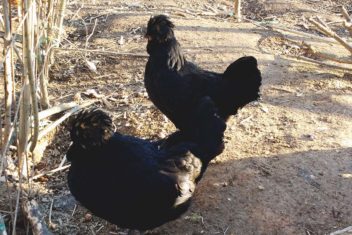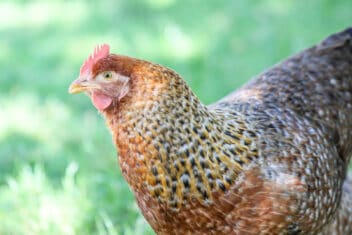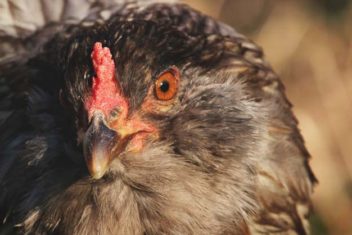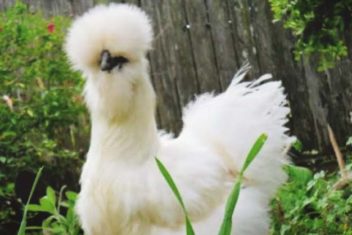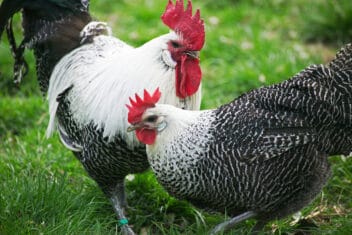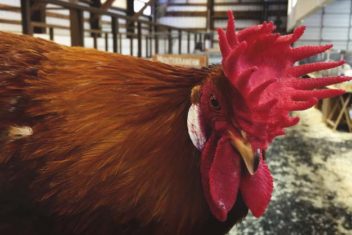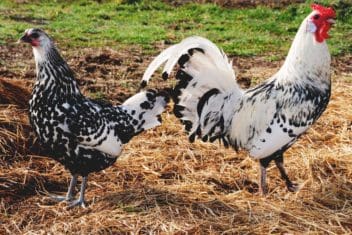I don’t know about you guys, but I have a thing for mottled chickens. I swore I’d never have bantams and then I fell in love with Mottled Cochin bantams and got two.
When I saw an Ancona Chicken, it caught my eye and turned my head 180 degrees. On top of their beauty, these birds are a very practical breed for any homestead, but especially in warmer climates due to their Mediterranean heritage.

About Ancona Chickens
This breed originates from Italy, where it was one of the most popular breeds around. In 1851, Anconas were imported to England where the breed was refined and bred for the markings it has today.
In 1888, the breed was imported to America and accepted into the American Poultry Association one year later.
Ancona Characteristics
1. Size and Weight
These are dainty little birds with petite frames. Full grown weight of an Ancona rooster is between 5.5 and 6.5 pounds. Hens weigh even less, tipping the scales at 4.5 pounds as a fully grown chicken.
2. Temperament
As with most Mediterranean breeds, the Ancona is not a particularly sociable bird. Most of the time these are somewhat flighty and skittish chickens, avoiding their caretakers unless they have a feed bucket in hand. Hens are not at all prone to broodiness and will hardly ever take to sitting on a clutch of eggs.
3. Egg Production
Egg production from the Ancona is actually quite good. Averaging about 220 eggs per year, this is a splendid option for your laying flock. The eggs that Anconas produce are large white eggs.
4. Meat Production
A quick glance at these chickens will probably tell you all that you need to know about meat production for this breed. It’s not fantastic by any stretch of the imagination.
Since the full grown weight of a rooster is only 6.5 pounds at best, it’s easy to see why this is the case. If you want a good breed that will both lay eggs and produce meat, look into chickens such as Wyandottes.
Caring for Ancona Chickens
1. Feeding and Nutrition
This is not a demanding breed as far as feed goes. It’s recommended to place your chicks on a good chick starter from hatch to 8 weeks of age. If your chick starter was a starter/grower combo, keep your grow-outs on this diet for a few more weeks.
If you don’t have a starter/grower combo for your chicks, it’s best to place them on this from 8-16 weeks old if possible. Between 16 and 18 weeks, make the final transition to laying feed for your pullets that should be coming into lay any day now.
2. Housing and Fencing
Anconas are flighty birds with wily personalities that make them good at evading predators. This makes the breed a good choice for a free-ranging flock. These chickens are also very good at flying and will need a high fence or covered run to contain your birds if they are in a run.
On the subject of runs, you’ll need to provide a minimum of 8-10 square feet per chicken in a run if you choose to use one. Inside the coop, 3-4 square feet per chicken is advised to keep a healthy environment for your birds.
3. Health Issues and Care
While all chickens are prone to an array of common and uncommon illnesses and health issues, Anconas are not overly susceptible to any diseases.
Your best method of prevention would be to maintain clean living quarters and keep a watchful eye on the behavior of your chickens. It’s also good to make sure your birds have good areas to dust bathe where they can kick around to manage external parasites such as mites and lice.
4. Breeding
When breeding Anconas, you will need to purchase an incubator due to the fact Anconas very rarely go broody. However, these birds are a fun bird to breed and have many fun traits to breed for.
When working on breeding your Anconas, one in every three feathers should be tipped with a heart-shaped mottled white.
Breed Alternatives
1. White Leghorns
Due to the similarity between White Leghorns and Anconas, Anconas are often referred to as Mottled Leghorns, despite the fact these two breeds are both their own distinct breeds.
Leghorns are also very active and flighty layers of large white eggs. In addition to their similarities in egg production and disposition, Leghorns weigh about the same as the Ancona.
2. Speckled Sussex
If you love the appearance of the Ancona but want a larger chicken, this is the breed for you.
The beautiful Speckled Sussex is a larger dual-purpose breed that can be used for both meat and egg production. The Speckled Sussex is also a much more sociable chicken than the Ancona.
Fun Facts about the Ancona
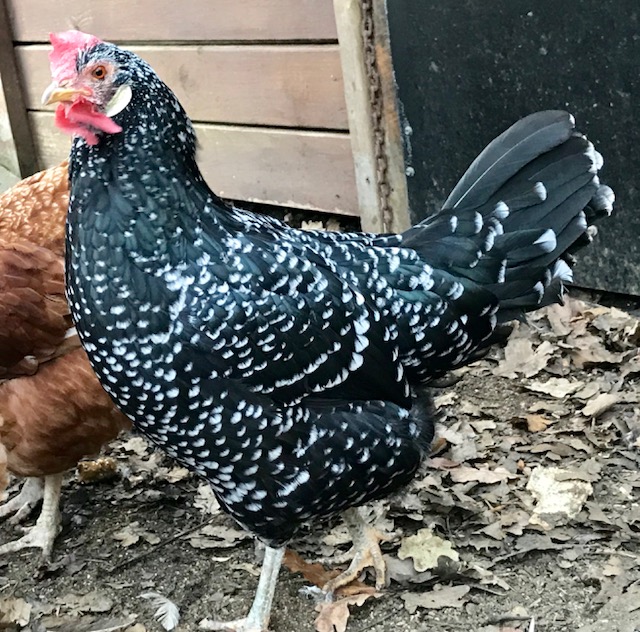
Ancona Chickens are fun birds because unlike color varieties, this breed has different comb varieties. The single comb and the rose comb varieties have both been accepted into the American Poultry Association.
It’s easy to pick your older Anconas out of the flock – look at their feathers! Every time an Ancona molts, it grows back more white feathers than before. So as you can imagine, by the time a hen is 3-5 years old, she’ll have a lot more white on her feathers than a young pullet.
So what is your opinion of this beautiful breed? Are they for you? I certainly think this is a stunning breed with fantastic egg production and a great fit for a farm where Ancona Chickens can free range to their heart’s content.


